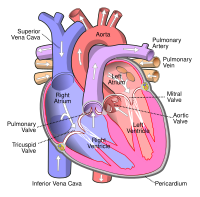
Photo from wikipedia
INTRODUCTION Radiofrequency ablation (RFA) of outflow tract ventricular arrhythmia (VA) that originate from the aortic cusps can be challenging. Long-term efficacy and safety data as well as optimal technique after… Click to show full abstract
INTRODUCTION Radiofrequency ablation (RFA) of outflow tract ventricular arrhythmia (VA) that originate from the aortic cusps can be challenging. Long-term efficacy and safety data as well as optimal technique after aortic cusp ablation have not previously been reported. OBJECTIVES This aim of the study was to determine the short- and long-term outcomes after RFA of aortic cusp VA, and to evaluate aortic valve injuries according to echocardiographic screening. PATIENTS AND METHODS This was a prospective multicenter registry (AVATAR) study. One hundred and three patients at the mean age of 56.0 years [34.0-64.0] from the "Electra" Registry (2005-2017) undergoing RFA of aortic cusps VA were enrolled. Three ablation techniques were used: zero-fluoroscopy- ZF (electroanatomical mapping- EAM without fluoroscopy), EAM with fluoroscopy and conventional fluoroscopy-based RFA. Clinical history, complications after RFA, echocardiography, and 24-hour Holter monitoring data were collected. The follow-up was ≥ 12 months. RESULTS There were no major acute cardiac complications after RFA. In one case, a vascular access complication required surgery. The median procedure time was 75.0 min [58.0-95.0], median follow-up- 32 months [12.0-70.0]. Acute and long-term procedural success rates were 93% and 86%, respectively. The long- term RFA outcomes were highest with ZF technique-88%, in EAM with fluoroscopy-86% and conventional RFA- 82%, however without significant differences. During long-term follow-up, no significant abnormalities were found within the aortic root. CONCLUSIONS Ablation of VA within the aortic cusps is safe and effective in long-term follow-up. The ZF approach is feasible, although it requires greater expertise and more imaging modalities.
Journal Title: Polish archives of internal medicine
Year Published: 2019
Link to full text (if available)
Share on Social Media: Sign Up to like & get
recommendations!